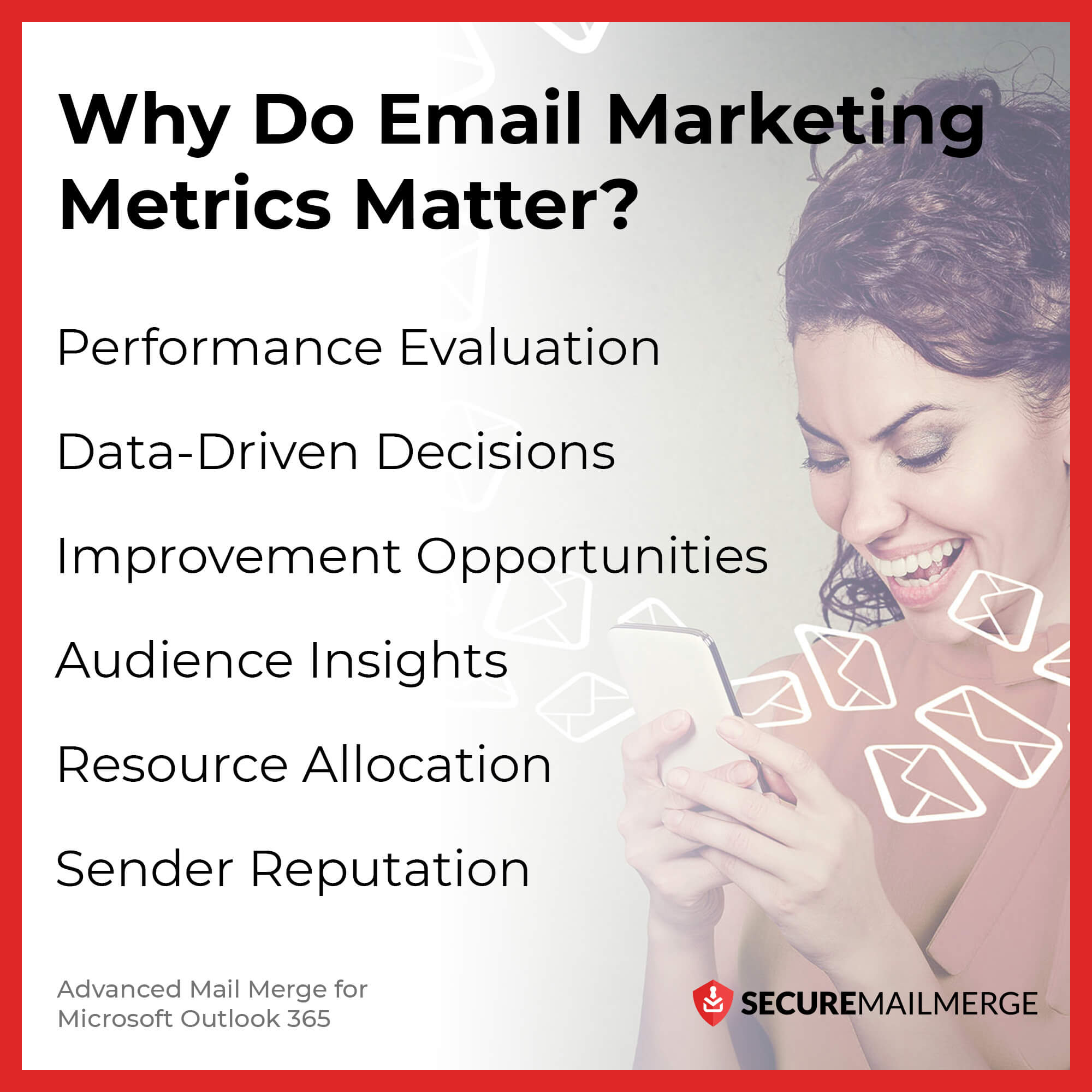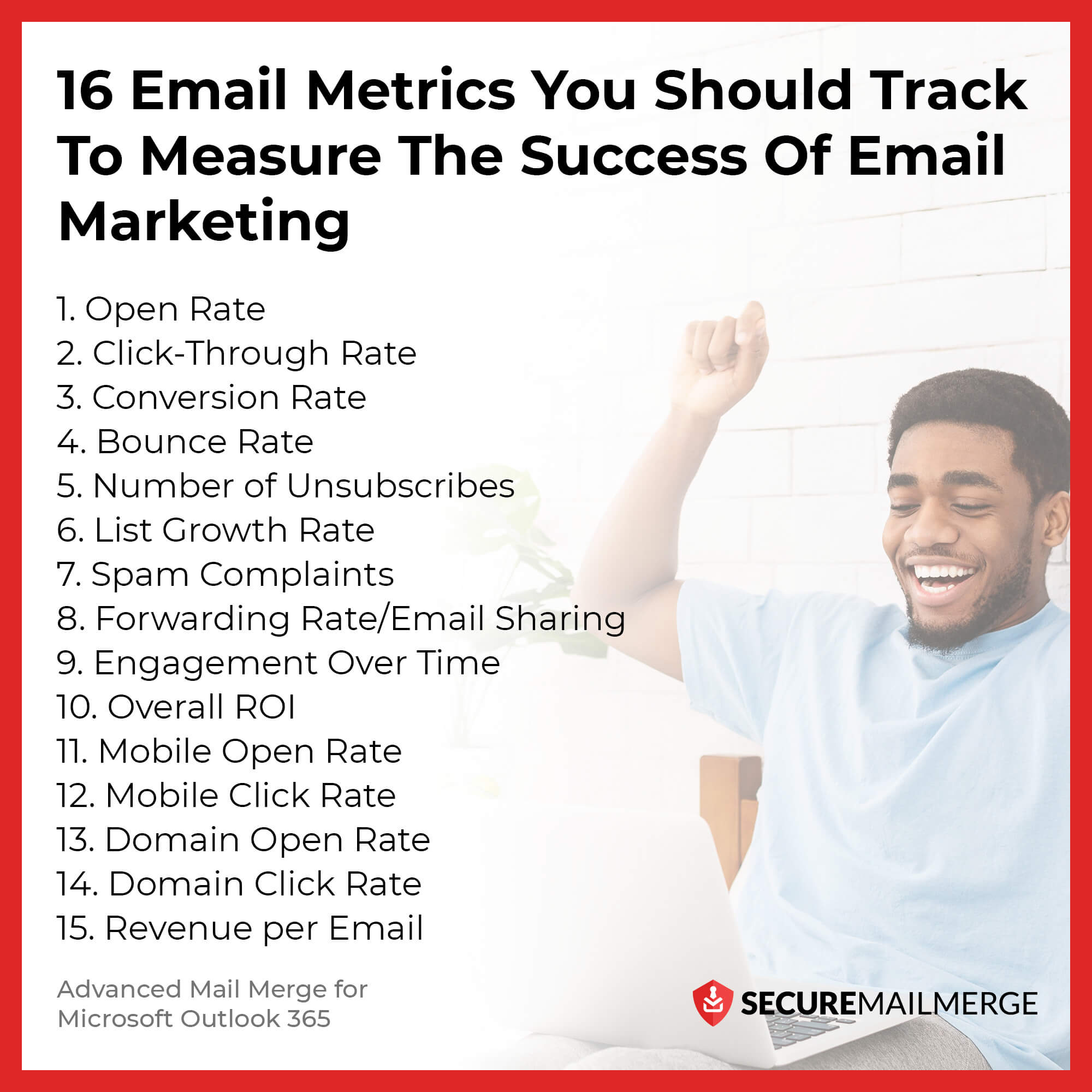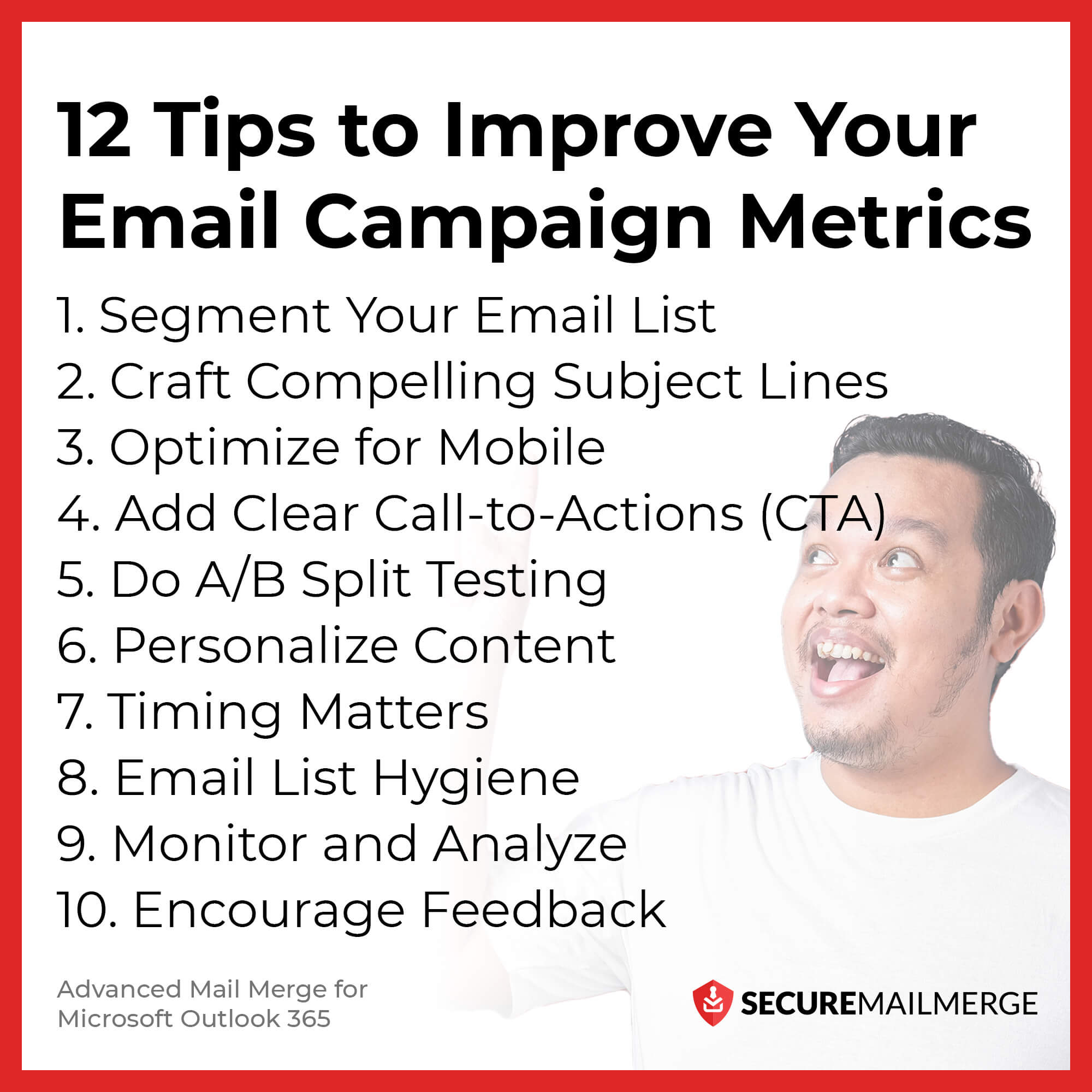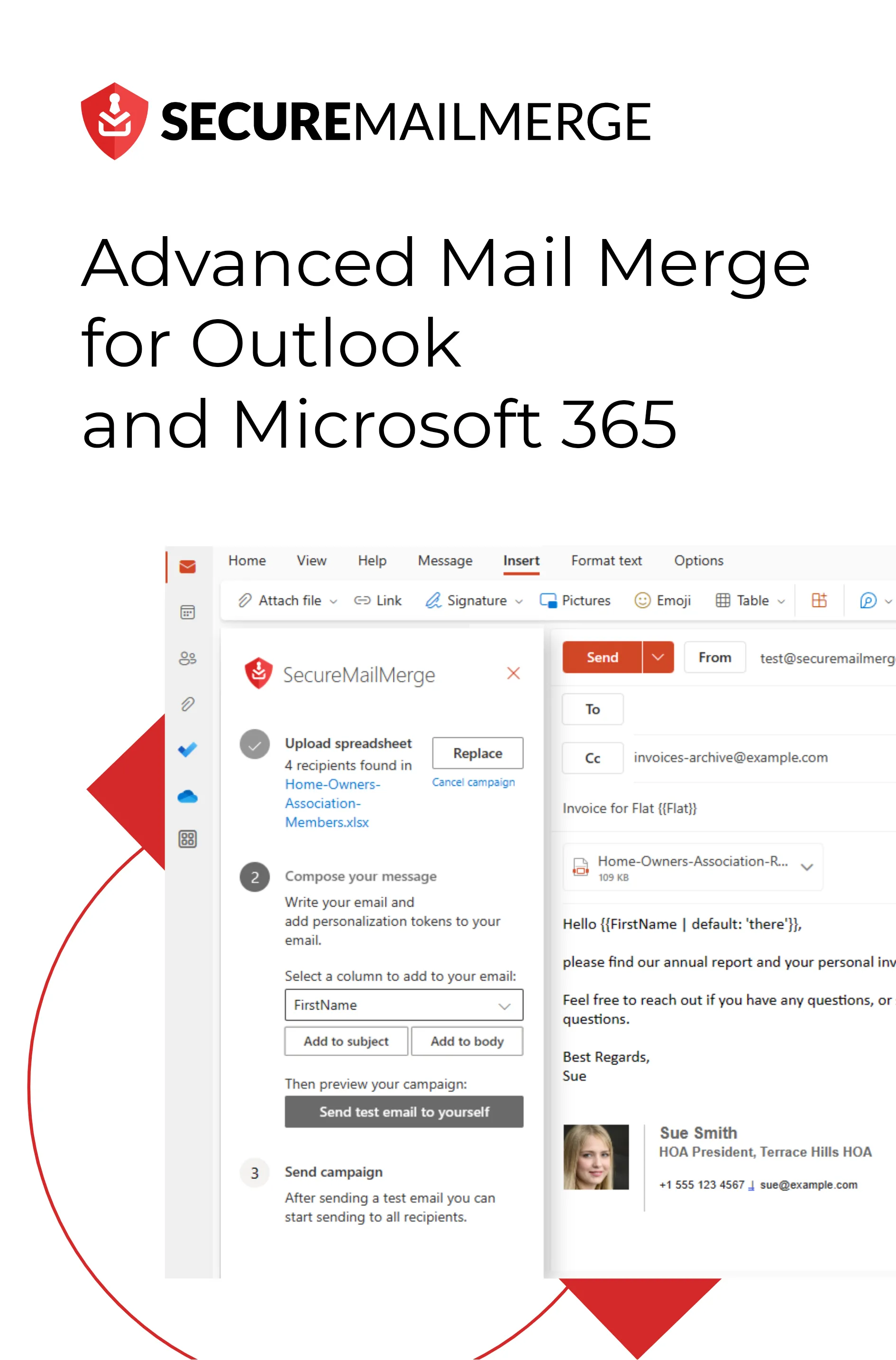Know how directly from the Microsoft 365 mail merge experts
16 Email Metrics To Track To Measure Your Email Marketing Success
Have you ever wished there was a way you could fine-tune your email strategies and drive better results?
You might be surprised to know that the answer to getting better (and more) leads has always been in front of you: email metrics!
In this article, we’ll explore the email marketing landscape to learn what email metrics are important in enhancing your email performance.
Let’s dive in!
What Are Email Metrics?
You might have seen the wordemail metrics tossed around in the email marketing community. Well, email metrics are one of the most crucial components of email marketing.
They are measurable data points that provide insights into how recipients engage with your email campaigns.
For email marketers, these metrics offer a window into various aspects of your marketing performance, helping you evaluate what’s working and what needs improvement.
Imagine if you could analyze and identify the shortcomings in your email campaigns.
As a marketer, peeking into your recipients’ minds and gauging their level of interest can do wonders for your email marketing. This is where email metrics can be your savior!
Why Do Email Marketing Metrics Matter?

Let’s say you’ve just launched an email marketing campaign to promote a flash sale of an up-and-coming e-commerce business.
The campaign is intricately designed, features beautiful visuals, and enticing discounts on the top-selling products.
After hitting the send button, here’s how email marketing metrics come into play:
- Performance Evaluation
Metrics enable you to assess the effectiveness of your email campaigns. They tell you what’s working and what isn’t. This way, you can craft a more compelling email campaign in the future.
- Data-Driven Decisions
With metrics, you can make informed decisions about your email marketing strategy.
For instance, if you see a low CTR, you can experiment with different content or calls to action.
- Improvement Opportunities
Metrics reveal areas that need improvement.
A high bounce rate may prompt you to clean your email list, while a low conversion rate could signal the need for more compelling offers. You’ll learn more about this in the next section.
- Audience Insights
Metrics provide valuable insights into your audience’s behavior and preferences. This helps you tailor your content to their interests.
Pro tip
Identifying your audience to create an effective email marketing strategy is essential. Find more about this in our How to Create A Winning Email Marketing Strategy in 2023 guide.
- Resource Allocation
Allocating resources smartly can be an intimidating job.
But, with email metrics, you can allocate your resources more effectively by understanding which campaigns generate the most revenue (ROI).
- Sender Reputation
Email metrics, especially spam complaints and bounce rates, impact your sender’s reputation. A poor reputation can lead to emails landing in spam folders instead of inboxes.
How to Measure Traditional Email Metrics?

These are the foundational metrics that help us gauge the performance and effectiveness of our email campaigns.
These include:
1. Open Rate
When you send out an email, the first step to success is opening it. The open rate tells you the percentage of recipients who opened your email. It’s like the initial nod of approval from your audience.
Calculation: Open Rate (%) = (Number of Opens / Number of Delivered Emails) x 100
Why It Matters
The open rate indicates how engaging your subject lines and sender name are. It reflects the effectiveness of your email’s first impression.
A high open rate often means your content is resonating with your audience.
Tip: Create an engaging subject line that immediately capturing your audience’s attention!
Example
Imagine you’re running an online clothing store, and you send out an email with the subject line “Exclusive 50% Off Sale Inside.” A high open rate suggests that your subscribers found the offer enticing because of the impactful subject line, which led them to open the email.
2. Click-Through Rate
Getting someone to open your email is great, but what matters is what they do next.
The click-through rate (CTR) measures the percentage of recipients who clicked on one or more links within your email. It’s like a journey to engagement.
Calculation: CTR (%) = (Number of Clicks / Number of Delivered Emails) x 100
Why It Matters
CTR shows how effectively your email content and call-to-action buttons guide recipients to take the desired actions, such as visiting your website, purchasing, or downloading an eBook.
Example
Let’s say you’re promoting a new e-book on gardening tips.
A high CTR means your email content and CTA buttons encourage readers to explore further by clicking the link to download the e-book.
3. Conversion Rate
Clicks are great, but conversions are the ultimate goal!
The conversion rate measures the percentage of people who clicked on your email and completed a specific action you intended, such as purchasing or signing up for a webinar. It’s a dream come true for every business owner!
Calculation: Conversion Rate (%) = (Number of Conversions / Number of Clicks) x 100
Why It Matters
Conversion rate reveals how persuasive and actionable your emails are. It helps you evaluate your campaigns’ impact on achieving your business goals.
Example
If you sent out an email offering a discount on your fitness equipment, a high conversion rate would mean that many recipients not only clicked on the offer but also went ahead and made a purchase.
4. Bounce Rate
Now, let’s talk about the_gaps_in email delivery.
Bounce rate measures the percentage of email addresses that didn’t receive your email. There are two types:
- Soft bounces (temporary issues)
- Hard bounces (permanent issues)
Calculation: Bounce Rate (%) = (Number of Bounced Emails / Number of Sent Emails) x 100
Why It Matters
A high bounce rate can indicate problems with your email list quality, like outdated or fake email addresses. It’s essential to maintain a clean list to ensure effective email marketing.
Example
Suppose you have a high percentage of hard bounces. In that case, it might be time to revisit your email acquisition strategy and implement double opt-ins to reduce fake or incorrect email entries.
5. Number of Unsubscribes
Finally, let’s talk about respecting youraudience’s choices.
The number of unsubscribes is a straightforward metric that tells you how many people opted out of receiving your emails after getting one from you.
Calculation: Unsubscribe Rate (%) = (Number of Unsubscribes / Number of Delivered Emails) x 100
Why It Matters
While it may sting to see people unsubscribing, it’s a healthy metric.
It means your audience is in control and can decide what content they want to receive. It’s better to have an engaged, consenting audience than to bother those who aren’t interested.
You wouldn’t want to get spammed with emails you’re not interested in, right?
Example
A temporary unsubscribe spike might occur if your email frequency increases due to a sales event. This is okay, as it helps refine your list to include those genuinely interested in your content.
Advanced Metrics
We’ve talked about the basic email metrics that concern every email marketer.
But, a whole realm of advanced metrics goes beyond the basics. These metrics can efficiently provide deeper insights into the performance of your campaigns.
These are:
6. List Growth Rate
Think of your email list as a garden; the list growth rate measures how fast it’s blooming.
To calculate it, subtract the number of unsubscribes from the number of new subscribers, divide by the total email addresses, and then multiply by 100.
Why It Matters
The list growth rate is a crucial indicator of your email marketing health. A growing list signifies that you’re successfully attracting new subscribers and offsetting those who opt out.
Example
Suppose you run a cooking blog and notice a 10% list growth rate. It means you’re consistently attracting new food enthusiasts who want to receive your delicious recipes.
7. Spam Complaints
Nobody wants their emails to end up in the spam folder.
This is where spam metrics can help you out.
Spam complaints measure the percentage of recipients who marked your messages as spam.
Why It Matters
High spam complaint rates can damage your sender’s reputation and deliverability. Monitoring this metric ensures emails hit the inbox instead of the dreaded spam folder.
Example
If your spam complaint rate suddenly spikes, it’s essential to investigate your email content and list quality to identify potential issues.
Pro tip
Wait to send many emails from a new mailbox in just one day! Take time and build trust with your email outreach.
Learn more about How to avoid emails going into spam in our guide.
8. Forwarding Rate/Email Sharing
Sometimes, your subscribers love your content so much that they become your advocates!
The forwarding rate or email sharing metric measures the percentage of recipients who shared your emails via social media or forwarded them to friends.
Why It Matters
A high forwarding rate indicates that your content resonates with your audience to the extent that they’re eager to share it. It’s like having your brand ambassadors.
Example
Imagine you run an online book club, and your newsletter includes a thought-provoking book recommendation. A high forwarding rate means your members found the proposal so compelling that they shared it with fellow bookworms.
9. Engagement Over Time
Timing matters in email marketing. Tracking engagement over time tells you when your audience is most active and responsive to your emails.
Why It Matters
Sending emails when your subscribers are most engaged can significantly boost open and click-through rates. It’s about maximizing your chances of catching their attention.
Example
If you’re a travel agency, your subscribers engage more with emails promoting weekend getaways when sent on Thursday evenings, helping you tailor your sending schedule.
10. Overall ROI
While return on investment (ROI) is not new, calculating it for your email marketing campaigns provides an overall view of their success.
To calculate it, subtract the money spent on the campaign from the money made in sales, divide by the money invested in the campaign, and multiply by 100.
Why It Matters
ROI helps you understand the financial impact of your email marketing. It tells you whether your campaigns generate more revenue than they cost, making it a vital metric for decision-making.
Example
Suppose you’re an e-commerce store owner, and your email campaign generated $5,000 in revenue while costing you $1,000 to run.
Your ROI is 400%, indicating that for every dollar spent on the campaign, you earned $4 in return.
Mobile Metrics
Mobile devices have become the preferred choice for checking emails. Interestingly, 61.9% of emails are opened on mobile phones.
That’s why understanding how your emails perform on mobile is crucial.
11. Mobile Open Rate
The mobile open rate is just like the regular available rate. Still, it focuses specifically on how your emails perform on mobile devices such as smartphones and tablets.
Why It Matters
Mobile, open rates often differ from desktop availability due to users’ varying habits. Tracking this metric helps you adapt your email content and timing for mobile users.
Example
If you’re a fashion retailer, you might notice that your mobile open rate spikes on Saturday mornings.
This insight can lead you to send your weekly fashion updates at this prime mobile engagement time.
12. Mobile Click Rate
Like the regular click-through rate, the mobile click rate measures how many mobile users clicked on the links within your emails.
Why It Matters
Mobile users may interact with emails differently than desktop users. Understanding the mobile click rate helps optimize your email design and content for better mobile engagement.
Example
If you’re a travel agency, mobile users are likelier to click on visually appealing images of exotic destinations.
This insight guides you to feature captivating visuals in your mobile-friendly emails.
Provider Metrics
Email providers play a significant role in delivering your emails.
Therefore, monitoring how different providers handle your emails is essential to attain valuable insights into your email marketing strategy.
13. Domain Open Rate
The domain open rate focuses on which email providers (like Gmail, Yahoo, or Outlook) your recipients use to open your emails.
Why It Matters
Different email providers may have unique spam filters or display preferences.
Knowing which domains your audience prefers can help you optimize your emails for better deliverability.
Example
If you’re a software company, most of your audience uses Outlook.
Tailoring your emails to look great in Outlook can improve your overall open rates for this segment.
14. Domain Click Rate
Like the domain open rate, the domain click rate tells you which email providers your recipients use when they click links within your emails.
Why It Matters
As with open rates, knowing which email providers your audience prefers to interact with can inform your email marketing strategy.
It helps ensure your links and content align with the provider’s rendering.
Example
If you run a fitness blog, you might discover that many of your Gmail readers actively engage with the workout routines you share.
This insight can encourage you to create more Gmail-friendly content.
15. Revenue per Email
Revenue per email measures the income generated by a specific email campaign, helping you identify your top-performing campaigns.
Why It Matters
Understanding which email campaigns generate the most revenue allows you to focus on the best strategies.
Example
If you own an online bookstore, your monthly newsletter featuring book discounts consistently generates substantial revenue per email.
This insight drives you to prioritize and enhance these newsletters.
16. Revenue per Subscriber
While revenue per email focuses on individual campaigns, revenue per subscriber zooms out to assess which demographics or segments of your email list contribute the most revenue.
Why It Matters
It helps you identify which subscriber groups are the most valuable, allowing you to refine your targeting and content strategies accordingly.
Example
If you manage a subscription box service, you might discover that subscribers aged 25-34 are your most potential demographic.
This insight guides you to create more tailored content and offers for this age group.
12 Tips to Improve Your Email Campaign Metrics

Here are some valuable tips to enhance your email campaign metrics and engage your audience effectively:
1. Segment Your Email List
Only send the same message to some. Segment your list based on demographics, behaviors, or preferences to deliver more relevant content. Personalization can significantly boost open and click-through rates.
2. Craft Compelling Subject Lines
Your subject line is the first thing recipients see. Make it enticing, relevant, and concise. A well-crafted subject line can entice subscribers to open your email.
And make sure that you avoid spam triggers.
Steer clear of spammy words or practices that can trigger spam filters. Keep your emails relevant and compliant with email marketing regulations.
3. Optimize for Mobile
With the growing number of g users checking emails on mobile devices, ensure your emails are mobile-responsive. Test how they appear on various mobile screens to provide a seamless experience.
4. Add Clear Call-to-Actions (CTA)
Make your CTA buttons stand out. Use action-oriented language and create a sense of urgency. A clear and compelling CTA can drive clicks and conversions.
5. Do A/B Split Testing
Experiment with different email elements, such as subject lines, images, CTA buttons, and content layout. A/B testing helps you identify what resonates best with your audience.
6. Personalize Content
Use recipient names and tailor content based on their preferences or past interactions. Personalization shows you value your subscribers and can increase engagement. You can also send follow-up emails to encourage a response.
You should also focus on creating valuable, informative, and engaging content. Address your subscribers’ pain points and provide solutions to keep them interested. Ensure that your email conveys the primary purpose of your message.
Here are 15 Tips for Clear and Effective Email Communication.
7. Timing Matters
Analyze when your audience is most active and send emails at those times.
Timing can impact open rates and overall engagement. And so can consistency in your schedule.
Whether weekly, bi-weekly, or monthly, consistency helps build anticipation among subscribers.
8. Email List Hygiene
Regularly clean your email list by removing inactive or bouncing email addresses. A clean list ensures better deliverability and engagement rates.
9. Monitor and Analyze
Continuously monitor your email metrics. Identify patterns and trends to refine your email strategy. Tools like Google Analytics and email marketing platforms provide valuable insights.
10. Encourage Feedback
Give your subscribers the option to provide feedback. Their insights can help you improve your email content and overall strategy.
Along with receiving feedback, make sure that you make it easy for subscribers to unsubscribe if they wish.
Remember, it’s better to have an engaged audience than a disinterested one.
Enjoyed this article?
We have a whole library of useful articles for you to read
Show me the library of Outlook articles